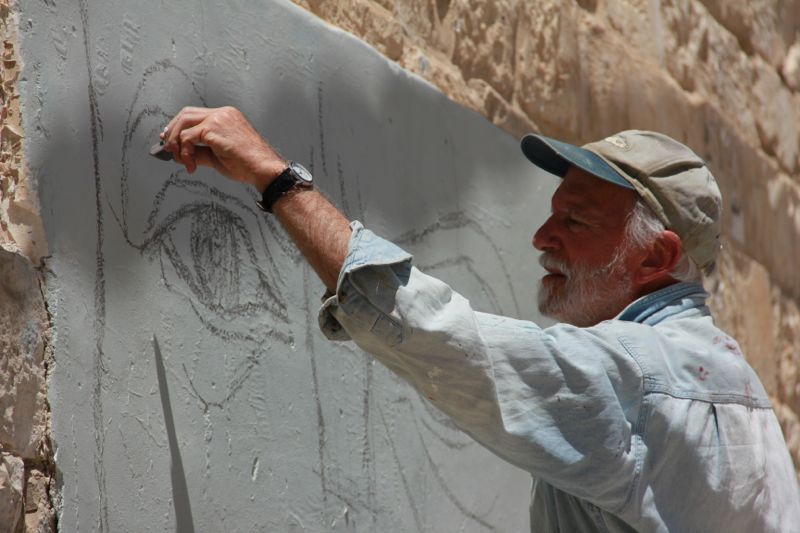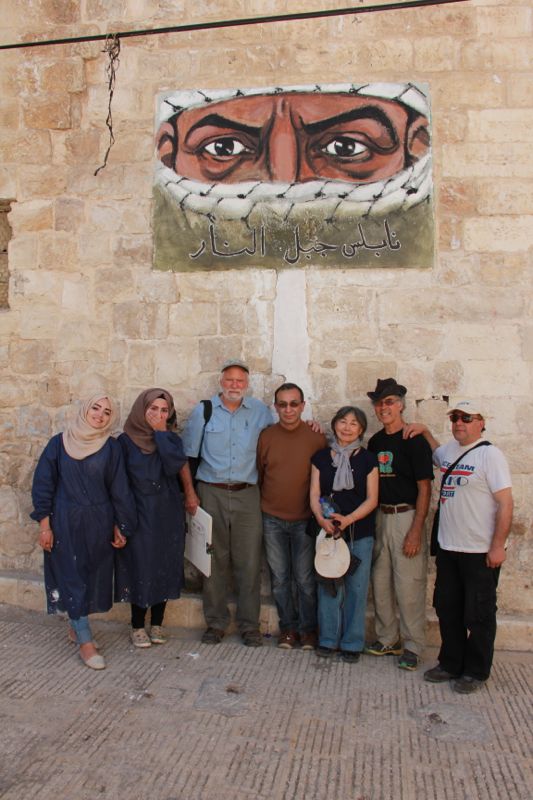What's New
Journey To Palestine with Barefoot Artists and Americans Who Tell the Truth: Art and (World) Citizenship
This report is written by Dud Hendrick, an Americans Who Tell the Truth board member and former president of the founding chapter of Veterans for Peace, lives in Deer Isle, Maine.
Read Rob Shetterly’s reaction to the separation wall, “Wailing at the Wall” here.
All photos courtesy of Sydney Chu
Rob Shetterly and I have just returned from an eye-opening, conscience-raising, heartening and heart-wrenching, gratifying yet disturbing, two weeks in Palestine and Israel.

As many of you know, Rob has devoted most of his waking hours to the Americans Who Tell the Truth project. Through several of his inspirational honorees he became aware of Lily Yeh and her work. Painting Lily’s portrait led to a friendship that first took these kindred spirits — Rob and Lily — to Rwanda to work with children and community in that war-ravaged place, then led Lily to invite Rob to join her on a mission to the West Bank of Palestine. Rob, in turn, invited me. We departed on April 15th and returned on the 29th. What we saw and heard has made clear our responsibility to join the growing campaign to shine a light on the apartheid in Palestine.
Lily Yeh has been bringing her art and spirit to ravaged communities for several decades. One can read of her work in greater depth at barefootartists.org. It is about raising hope through art. Her mission statement reads:
“Recognizing that creativity and beauty are powerful agents for healing and change, Barefoot Artists works with poor communities around the globe practicing the arts to bring healing, self-empowerment, and social change.”
In Palestine, we would be working in Balata, the refugee camp, close by the city of Nablus, where 30,000 are housed in ¼ square kilometer. Many of these people arrived here in 1948 having been displaced when the UN, operating on the notion of “a land without people for a people without land”, created the modern state of Israel.
The centerpiece of our work would be at the Women’s Center at Balata where local art students and children from the camp joined us to transform the modest courtyard.

We would go on from the Balata project to work barefoot artist-magic at the village of Al Aqaba and in the Old City of Nablus—both places of deep symbolic significance.

The genius of Lily Yeh is proven not only in her transformative art, but also, at least in this instance, in a charisma that forged a productive team of disparate parts: Our guide, Majdi Shella, is a native of Nablus, whose personal history has shaped a resilient but scarred humanist, dedicated to peaceful resolution—what he terms ‘cultural resistance’. Two close friends, Sidney Chu, a consummate photographer, and Sophia Dhu, a sensitive caregiver, both of whom had collaborated with Lily in a project devoted to an indigenous community in their Taiwanese village joined us. Rounding out the team were Rob, whose contribution to the mural work, of course, was enormous, and me. Though not an artist, my participation may have enriched our experience. Lily, consistent with her objective of exploring the interests of all participants, had developed an itinerary designed to enable a broad introduction to the conflict that besets Israel and Palestine—a goal shared by Rob and me.
The highlights:
- Attending and participating in the Spring Festival of Nablus which recognizes and celebrates the 5000 prisoners of conscience incarcerated in Israeli prisons today.
- Visiting a former prison, the place of Majdi’s first incarceration and hearing in his own words the consequences of boyhood stone-throwing at Israeli soldier.
- Workshops and mural-painting in Al Aqaba.
- Getting to know Al Aqaba and the principle characters who have been instrumental in the defiant rebuilding of this community which had been subject to Israeli demolition orders and casualties inflicted by inhumane military “training exercises.”
- Painting a mural in the Old City of Nablus which had been laid waste by Israeli forces during the second intifada.
- Witnessing and participating in the weekly protest of the “separation barrier” at Bil’in, the village made widely known by “Five Broken Cameras”, directed by Ehad Burnat.
- Participating in a conversation in the home of Ehad’s brother, Iyad, who has spoken widely in the U.S. Included were other village leaders and Yonatan Shapira, the former Israeli pilot turned refusnik and activist.
- Visiting the memorial for revered Palestinian poet, Mahmoud Darwish.
- Meeting and receiving a private lecture by Palestinian scholar and activist, Mazin Qumsiyeh.
- Seeing close-up and personal “the wall” and settlements in and around Bethlehem on a guided tour granted us by Qumsiyeh’s wife, Jesse Chang.
- Meeting Palestinian graphic artist Amer Amin and discussing his art as cultural intervention.
- Meeting and interviewing Ronnie Barkan, Israeli activist.

All of our individual objectives were surpassed, I believe, in service of Lily’s mission. We realized a successful union of Barefoot Artists, an American Who Tells the Truth, and a Veteran for Peace. We all were involved in using art to transform and build community, and all of us, by standing in witness acknowledged that our country shares responsibility for what is being done to the Palestinian people.
The single aspect, though, that enabled us all to feel satisfaction in what I think is a universal need to connect to the other, was made possible by Rob’s unfailing generosity. On learning of his talent and willingness many acquaintances asked him to sketch their portrait. As a result the 200-plus honored Americans have been joined by 20-plus Palestinians who tell the truth, we have come to believe, about apartheid.
